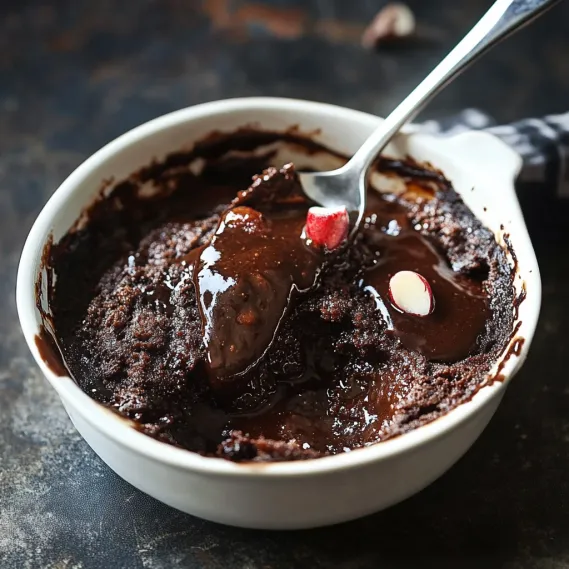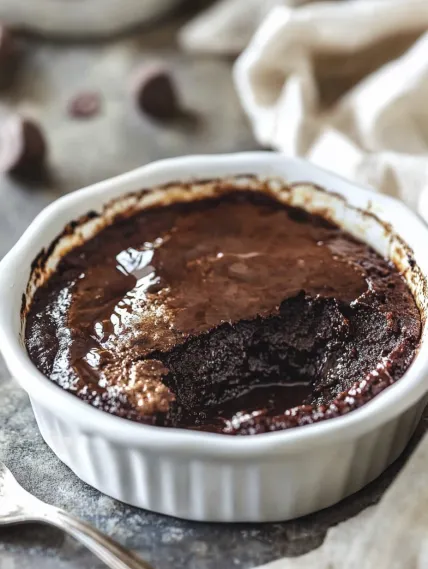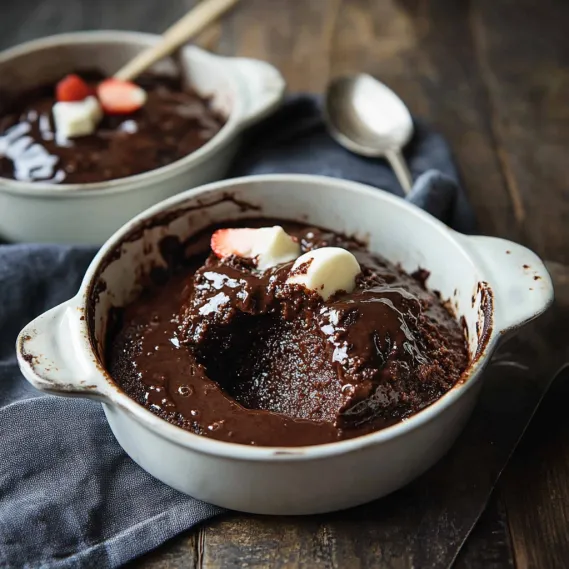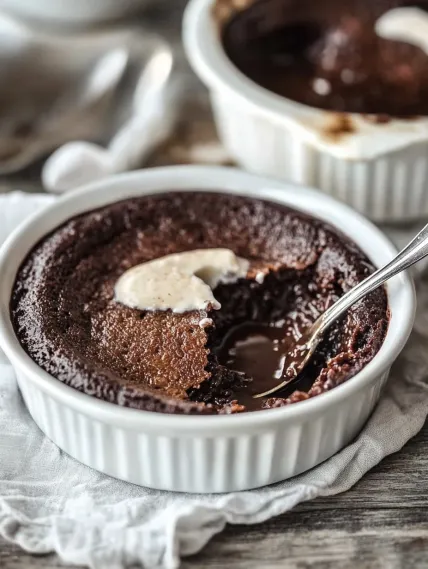 Pin it
Pin it
This amazing chocolate self-saucing pudding makes two yummy layers all by itself – a soft, fluffy chocolate cake sitting on top of a smooth chocolate sauce that appears like magic. The difference between the cake layer and the runny sauce underneath makes a warm, cozy dessert that hits the spot for chocolate lovers without much work. You can whip it up in less than an hour using stuff you probably already have at home, and it'll wow everyone whether it's just family movie night or you've got friends over. When you break through that slightly crunchy top and find the hidden sauce waiting below, you'll see why this simple pudding has stuck around as a favorite for so long.
I first tried making this dessert when friends were coming over and I couldn't get to the store. What really caught me off guard was how everyone thought I'd done something complicated – one simple mix turning into two different layers! My buddy's kid who's seven told me it was "way better than what restaurants make" and always asks for it when they stop by. What's great about this pudding is that it really does amaze people even though it's super easy to make.
Key Ingredients and Smart Picking Tips
- Cocoa Powder: Pick unsweetened for the strongest chocolate taste. Dutch-processed gives you darker, richer results, but standard cocoa works fine too.
- Brown Sugar: Adds richness and moisture to the sauce. You can use light or dark depending on how intense you want the flavor.
- Butter: When melted, it makes the cake part soft. Go with unsalted so you can control the overall taste better.
- Milk: Brings wetness to the mix. Whole milk offers the best richness, though any type will do the job.
- Boiling Water: This is what creates the magical sauce effect. Make sure it's actually boiling for the best outcome.
After trying this many times, I've found that getting the right amount of water compared to sugar in the topping really matters. Using a bit more water gives you a properly flowing sauce instead of something too thick, which I think tastes much better when you're eating it.
Step-by-Step Cooking Guide
- Step 1: Get Your Dish Ready
- Heat your oven to 170°C (335°F) and put plenty of butter in a 1.5-liter baking dish. The dish size really matters - too big and your sauce will be too thin; too small and it might spill over. Something around 25cm x 20cm (10" x 8") with sides at least 5cm (2") tall works great.
- Step 2: Mix Up The Batter
- In a big bowl, stir together 1 cup plain flour, 2½ teaspoons baking powder, ⅓ cup white sugar, ¼ cup cocoa powder, and a tiny bit of salt. In another bowl, mix ½ cup milk, 50g melted butter, 1 egg, and 1 teaspoon vanilla extract. Pour the wet stuff into the dry ingredients and stir until everything's just mixed into a thick batter, then spread it evenly in your buttered dish.
- Step 3: Sprinkle The Magic Stuff
- In a small bowl, mix 1 cup brown sugar and ¼ cup cocoa powder, then scatter this mix evenly over your batter. Gently shake the dish to spread the sugar mix in an even layer. The sugar and cocoa will work their magic while baking to make your sauce.
- Step 4: Add The Secret Ingredient
- Pour 1¼ cups boiling water over the back of a spoon onto the sugar-cocoa layer, trying to spread it evenly across the whole top. This might seem weird, but the hot water is what makes the sauce form under the cake while it bakes. Don't mix it - the layers need to stay separate.
- Step 5: Bake It Just Right
- Bake for 30 minutes until the top feels springy when you touch it lightly. The surface should look a bit crackly, kind of like brownies, but the cake should still feel soft underneath. Let it sit for only 2-3 minutes, then serve it right away while the sauce is still flowing under the cake part.
 Pin it
Pin it
The first time I made this pudding, I almost ruined it by mixing the water into the topping, which messed up the layer separation. Now I know that fighting the urge to stir is super important for getting that cool two-texture result.
Mastering Your Wok Cooking Skills
You really need super hot temps for real fried rice. My grandma always told me to heat the wok till it's smoking before adding any oil. Keep everything moving all the time to get that special "wok hei" flavor. Don't try cooking too much at once—do smaller batches instead. This way of cooking turned my fried rice into something that tastes just like restaurant food.
 Pin it
Pin it
Clever Uses For Leftover Food
This dish turns old food into something totally new and tasty. I've thrown in leftover roast chicken, holiday ham, and even turkey from Thanksgiving with great results. Just cut all meat into same-sized pieces so they spread out nicely. Leftover grilled steak adds amazing flavor with those smoky bits. Even roasted veggies bring a nice sweet taste from their browned edges.
Getting Tastes And Textures Just Right
Good fried rice needs a mix of different things. Char siu adds fatty goodness, prawns give sweetness, eggs make everything creamy, and veggies add crunch. The order matters too—flavor builders go in first, eggs go in the middle so they stay visible, veggies cook less so they stay crisp. Adding green onions last keeps them fresh for that real restaurant taste.
Changing Things For Different Diets
This dish works for almost any diet needs. For vegetarians, I skip the meat, use more eggs and throw in extra veggies. People watching carbs love my version with cauliflower rice that soaks up all the flavors. For folks who can't eat gluten, I use tamari instead of soy sauce and make sure the chicken powder doesn't have gluten. Everyone can enjoy this popular dish no matter what they can or can't eat.
What To Serve It With
This pudding tastes great by itself, but adding the right sides makes it even better. A scoop of vanilla ice cream creates an awesome hot-cold mix as it melts into the warm pudding. When friends come over, I add lightly whipped cream and fresh berries, which cut through the rich chocolate taste. In fall and winter, I pair it with cooked pears and a little caramel sauce for a fancy dessert that still feels homey. Coffee fans in my family like having it with a small espresso, which makes the chocolate taste even better. For big get-togethers, I set up a pudding topping bar with crushed nuts, chocolate shavings, and fresh mint leaves so everyone can make their own version.
Tasty Twists To Experiment With
While I usually stick with the classic chocolate recipe, I've played around with some changes that my family now loves. For coffee lovers, just add 1 tablespoon of instant espresso powder to the mix. If you like orange and chocolate together, throw in 1 tablespoon of orange zest to the cake part. For special times, I sometimes add 2 tablespoons of Baileys or Kahlúa to the batter and another tablespoon to the sauce ingredients. My richest version includes mixing in ⅓ cup of chocolate chips into the batter before baking, making little pockets of melted chocolate throughout. All these different versions follow the same basic steps but give you new flavors to try.
Prep-Ahead Options
This pudding tastes best fresh out of the oven, but I've figured out some shortcuts for when you're busy hosting. You can mix the dry stuff for both the batter and topping separately and keep them in sealed containers up to a week ahead. You can even butter your dish early and keep it covered in the fridge. When company shows up, just mix in the wet ingredients, combine with your pre-measured dry mix, put it all together, and bake. When organized this way, the pudding only takes about 10 minutes of actual work, which is perfect when you're entertaining. For really last-minute situations, I've made the whole pudding up until baking, kept it in the fridge for up to 2 hours, then added an extra 5 minutes to the baking time and it still turned out great.
 Pin it
Pin it
This chocolate self-saucing pudding has come to my rescue at countless dinner parties and family gatherings when I needed something quick but impressive for dessert. My favorite part is watching people's reactions when they dig in and find that hidden sauce under the cake – that look of surprise never gets boring. The mix of simple ingredients, minimal effort, and magical outcome makes this basic pudding a go-to in my dessert collection, showing that sometimes the tastiest treats are also the easiest ones to make.
Frequently Asked Questions
- → Why doesn’t my sauce stay thick?
- The sauce might need additional oven time to thicken. Double-check that you added the correct ratio of cocoa and sugar—these are crucial for the texture.
- → Can I prepare this ahead?
- It’s better to bake this fresh, as the cake absorbs the sauce if stored too long. But you can prep the batter and topping separately and bake when ready.
- → Can cocoa powder be swapped out?
- This recipe is designed for cocoa powder. Using dark chocolate changes the way the sauce sets up, so it’s best to stick to cocoa for the right balance.
- → How should I reheat leftovers?
- Heat a portion in the microwave for 20-30 seconds until warm. Adding a small splash of hot water before reheating helps recreate the sauce.
- → Can I use individual ramekins?
- Yes, you can divide the batter into small ramekins. Sprinkle the topping and pour water gently before baking for 15-20 minutes. Check when the tops spring back.
- → Why didn’t my sauce form properly?
- Pouring the hot water too quickly might have mixed it with the batter. Slowly pour the water over a spoon to avoid disrupting the layers.
